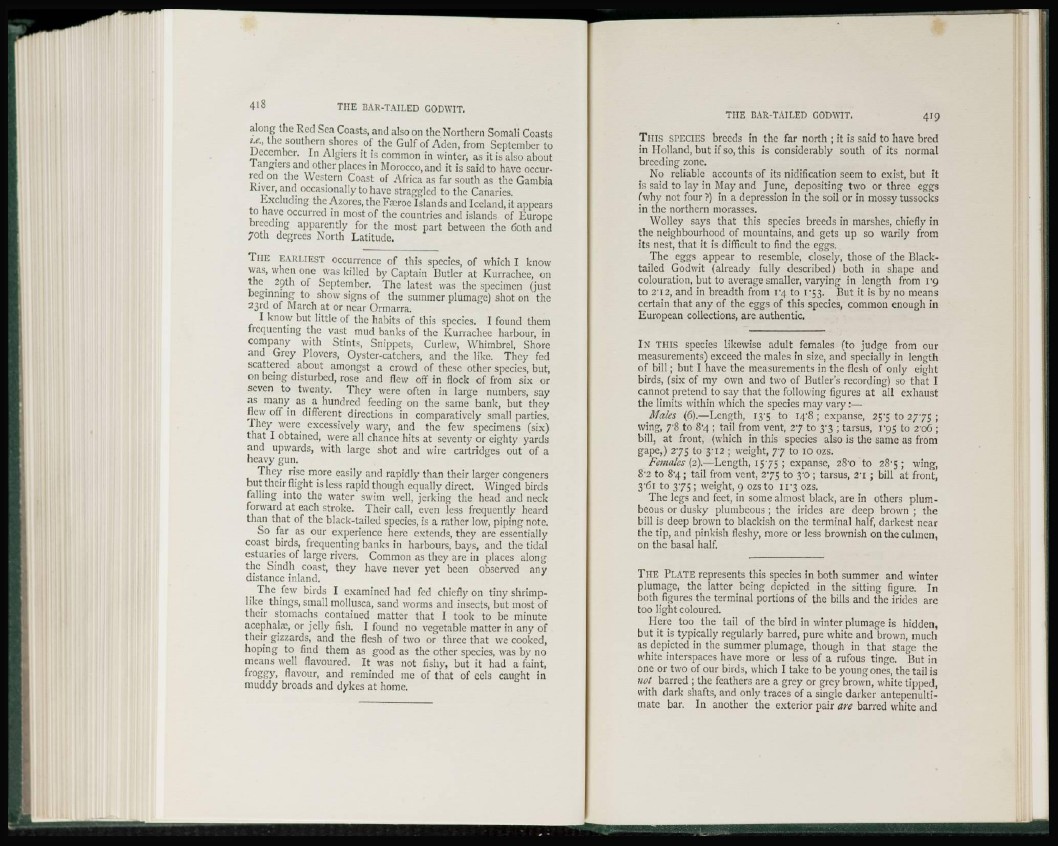
along the Red Sea Coasts, and also on the Northern Somali Coasts
2>., the southern shores of the Gulf of Aden, from September to
December. In Algiers it is common in winter, as it is also about
Tangicrs and other places in Morocco, and it is said to have occurred
on the Western Coast of Africa as far south as the Gambia
River, and occasionally to have straggled to the Canaries.
Excluding the Azores, the Faroe Islands and Iceland, it appears
to have occurred in most of the countries and islands of Europe
breeding apparently for the most part between the 6oth and
70th degrees North Latitude.
THE EARLIEST occurrence of this species, of which I know
was, when one was killed by Captain Butler at Kurrachee, on
the 29th of September. The latest was the specimen (just
beginning to show signs of the summer plumage) shot on the
23rd of March at or near Ormarra.
I know but little of the habits of this species. I found them
frequenting the vast mud banks of the Kurrachee harbour, in
company with Stints, Snippets, Curlew, Whimbrel, Shore
and Grey Plovers, Oyster-catchers, and the like. They fed
scattered about amongst a crowd of these other species, but,
on being disturbed, rose and flew off in flock of from six or
seven to twenty. They were often in large numbers, say
as many as a hundred feeding on the same bank, but they
flew off in different directions in comparatively small parties.
They were excessively wary, and the few specimens (six)
that I obtained, were all chance hits at seventy or eighty yards
and upwards, with large shot and wire cartridges out of a
heavy gun.
They rise more easily and rapidly than their larger congeners
hut their flight is less rapid though equally direct. Winged birds
falling into the water swim well, jerking the head and neck
forward at each stroke. Their call, even less frequently heard
than that of the black-tailed species, is a rather low, piping note.
So far as our experience here extends, they are essentially
coast birds, frequenting banks in harbours, bays, and the tidal
estuaries of large rivers. Common as they are in places along
the Sindh coast, they have never yet been observed any
distance inland.
The few birds I examined had fed chiefly on tiny shrimplike
things, small mollusca, sand worms and insects, but most of
their stomachs contained matter that I took to be minute
acephal.ne, or jelly fish. I found no vegetable matter in any of
their gizzards, and the flesh of two or three that we cooked,
hoping to find them as good as the other species, was by no
means well flavoured. It was not fishy, but it had a faint,
froggy, flavour, and reminded me of that of eels caught in
muddy broads and dykes at home.
THIS SPECIES breeds in the far north ; it is said to have bred
in Holland, but if so, this is considerably south of its normal
breeding zone.
No reliable accounts of its nidification seem to exist, but it
is said to lay in May and June, depositing two or three eggs
(why not four ?) in a depression in the soil or in mossy tussocks
in the northern morasses.
Wolley says that this species breeds in marshes, chiefly in
the neighbourhood of mountains, and gets up so warily from
its nest, that it is difficult to find the eggs.
The eggs appear to resemble, closely, those of the Blacktailed
Godwit (already fully described) both in shape and
colouration, but to average smaller, varying in length from rg
to 2'12, and in breadth from 1-4 to 1-53. But it is by no means
certain that any of the eggs of this species, common enough in
European collections, are authentic.
IN THIS species likewise adult females (to judge from our
measurements) exceed the males in size, and specially in length
of bill; but I have the measurements in the flesh of only eight
birds, (six of my own and two of Butler's recording) so that I
cannot pretend to say that the following figures at all exhaust
the limits within which the species may vary:—
Males (6).—Length, 13-5 to 14-8; expanse, 25-5 to 2775 ;
wing, 78 to S'4 ; tail from vent, 27 to 3'3 ; tarsus, i'95 to 206 ;
bill, at front, (which in this species also is the same as from
gape,) 275 to 3'12 ; weight, 77 to 10 ozs.
Females (2).—Length, 1575 ; expanse, 28'0 to 28'5 ; wing,
8'2 to 8'4; tail from vent, 275 to 3'0; tarsus, 21 ; bill at front,
3'6i to 375 ; weight, 9 ozs to 11 "3 ozs.
The legs and feet, in some almost black, are in others plumbeous
or dusky plumbeous ; the irides are deep brown ; the
bill is deep brown to blackish on the terminal half, darkest near
the tip, and pinkish fleshy, more or less brownish on the culmen,
on the basal half.
THE PLATE represents this species in both summer and winter
plumage, the latter being depicted in the sitting figure. In
both figures the terminal portions of the bills and the irides are
too light coloured.
Here too the tail of the bird in winter plumage is hidden,
but it is typically regularly barred, pure white and brown, much
as depicted in the summer plumage, though in that stage the
white interspaces have more or less of a rufous tinge. But in
one or two of our birds, which I take to be young ones, the tail is
not barred ; the feathers are a grey or grey brown, white tipped,
with dark shafts, and only traces of a single darker antepenultimate
bar. In another the exterior pair are barred white and